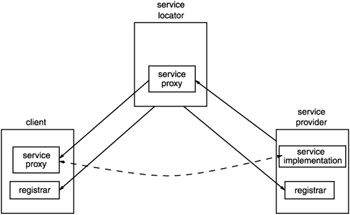176.
|
ProxiesSome services can be implemented by a single object, the service object. How does this work if the service is actually a toaster, a printer, or is controlling some piece of hardware? By the time the service object runs in the client's JVM, it may be a long way away from its hardware. It cannot control this remote piece of hardware all by itself. In this situation, the implementation of the service must be made up of at least two objects, one running in the client and another distinct one running in the service provider. The service object is really a proxy, which will communicate with other objects in the service provider, probably using RMI. The proxy is the part of the service that is visible to clients , but its function will be to pass method calls back to the rest of the objects that form the total implementation of the service. There isn't a standard nomenclature for these server-side implementation objects. I shall refer to them in this book as the service backend objects. The motivation for discussing proxies is the situation in which a service object needs to control a remote piece of hardware that is not directly accessible to the service object. However, this need not involve hardware ”there could be files accessible to the service provider that are not available to objects running in clients. There could be applications local to the service provider that are useful in implementing the service. Or it could simply be easier to program the service in ways that involve objects on the service provider, with the service object being just a proxy. The majority of service implementations end up with the service object being just a proxy to service backend objects, and it is quite common to see the service object being referred to as a service proxy. It is sometimes referred to as the service proxy even if the implementation doesn't use a proxy at all! The proxy needs to communicate with other objects in the service provider, but this begins to look like a chicken-and-egg situation: how does the proxy find the service backend objects in its service provider? Use a Jini lookup? No, when the proxy is created it is "primed" with its own service provider's location so that when it is run it can find its own "home," as illustrated in Figure 1-9.  Figure 1-9: A proxy service How is the proxy primed? This isn't specified by Jini, and it can be done in many ways. For example, an RMI naming service can be used, such as rmiregistry , where the proxy is given the name of the service. This isn't very common, as RMI proxies can be passed more directly as returned objects from method calls, and these can refer to ordinary RMI server objects or to RMI activable objects. Another option is that the proxy can be implemented without any direct use of RMI and can then use an RMI-exported service or some other protocol altogether, such as FTP, HTTP, or a home-grown protocol. These various possibilities are all illustrated in later chapters. | ||||
EAN: N/A
Pages: 189
If you may any questions please contact us: flylib@qtcs.net
